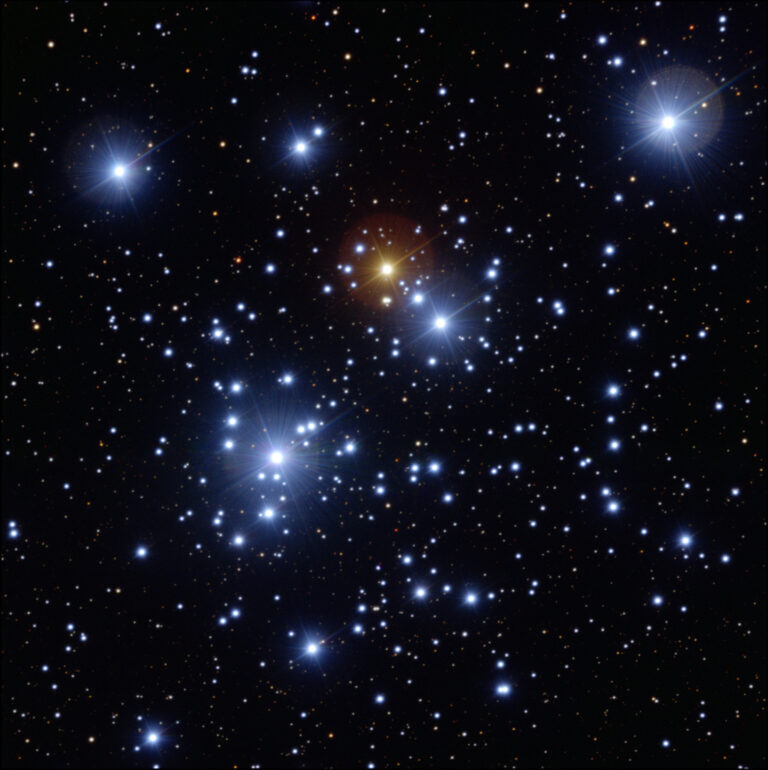Key Takeaways:
It’s a piece of cake. Most stars are dim and cursed with designations like HD 140283 or Zubenelgenubi. Only a handful are brilliant and have popular names. Of them, just one floats directly overhead at this time of year. So it’s automatic. Vega (Alpha [α] Lyrae) selects itself.
Of all bright stars, Vega boasts the shortest name — and one of the most familiar. Yet it’s routinely mispronounced. That’s because few know this phonetics tip: Star names are simple transliterations from their original language. You usually should pronounce them as spelled. Rigel is really RY-jl, Spica is really SPY-kah, and Vega is really VEE-gah. No need to add a Latin twist — even if that’s how Jodie Foster bewilderingly said it in the movie Contact.
Vega was, until the 19th century, pronounced WEE-gah and even spelled Wega in some antique astronomy books. It derives from Arabic and means “a swooping eagle.” It also was an eagle to the ancient Indians and a vulture to the Egyptians. A bird. Don’t ever let a friend turn it into a cigar by saying VAY-gah, even if one or two criminally incompetent dictionaries list it that way.
Look overhead just as night falls. From most of the United States, Vega is the only bright star that ascends to within a few degrees of the exact zenith. (It’s straight up from the nation’s capital.) Shining at a steady magnitude 0, Vega serves as the “standard candle” that the worldwide astronomical community used to calibrate the brightness of everything else in the universe. Like the French bar of platinum once used to define the meter, Vega functions as the sky’s reference point for the magnitude system. It’s an ideal choice because it displays no flickering or variability, despite years of controversy about this. Moreover, it’s a single star like the Sun instead of a binary like so many others.
But it’s still not quite a monument to normalcy. In the 1990s, a team of Canadian astronomers announced that Vega, like a fortune-cookie writer, exhibits bizarre peculiarities. It spins crazily in 12 hours, compared to a month for our Sun, despite being nearly three times larger. If it rotated just 18 percent faster, it would break apart.
ARE AS COMMON AS TATTOOS,
THIS DIAMOND AT THE ZENITH
DISPLAYS A BLUESHIFT.
Some 12,000 years from now, we’ll return the favor. Vega periodically becomes our pole star as Earth’s axis wobbles through its 26-millennium precession. Brightest of all our planet’s north stars, it nonetheless misses the celestial stationary point by some 4°. So it never achieves the visual glued-in-place appearance of the current award-winner, Polaris.
Vega has enjoyed more than 15 minutes of fame. It was the first star to be photographed — a feat attained at the exact midpoint of the 19th century, a whopping 163 years ago. It was also the first to have its spectrum taken and, for those who own a star spectroscope, displays a gorgeous mélange of reds, greens, and blues in equal amounts, crossed by prominent dark Balmer lines of hydrogen. Floating a mere 25 light-years from us, Vega is a heavyweight with more than twice our Sun’s mass and 36 times its luminosity.
Members of a major vegetarian subculture call themselves vegans, but no one knows if the cuisine on Vega is truly meatless. In any case, vegan ancestors likely did not hail from there. Despite being encircled by a dusty disk with a strong infrared signature that some astronomers have interpreted as evidence of a planetary system, actual life is implausible be-cause of the star’s youth, less than one-tenth the age of Earth and our Sun.
As if this weren’t enough to keep us interested, Vega marks the approximate direction we travel toward in space. As our entire starry neighborhood participates in the Milky Way’s grand rotation, we do a little 9-mile-per-second (14 km/s) sideslip in Vega’s general direction. In a cosmos where redshifts are as common as tattoos, this diamond at the zenith displays a blueshift. It’s heading our way.
So enjoy nightfall’s overhead chess game as this season’s brightest stars zoom off in different directions. As the centuries pass, orange Arcturus in the west will totally vanish from sight while Vega grows ever brighter. Some 200 millennia hence, it will enrapture our descendants as the sky’s most brilliant star. Celebrated even more than it is today, Vega will retain that honor for the next quarter-million years.
Contact me about my strange universe by visiting http://skymanbob.com.










